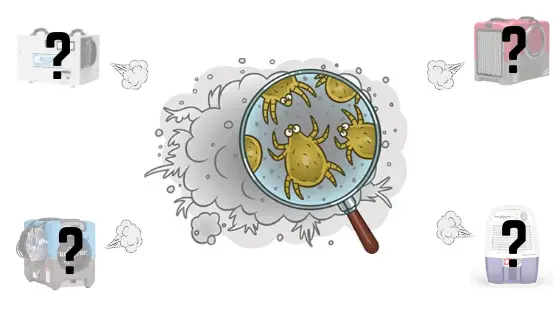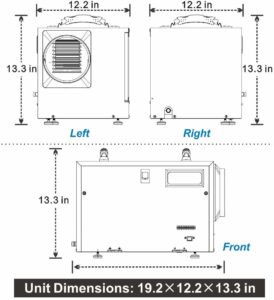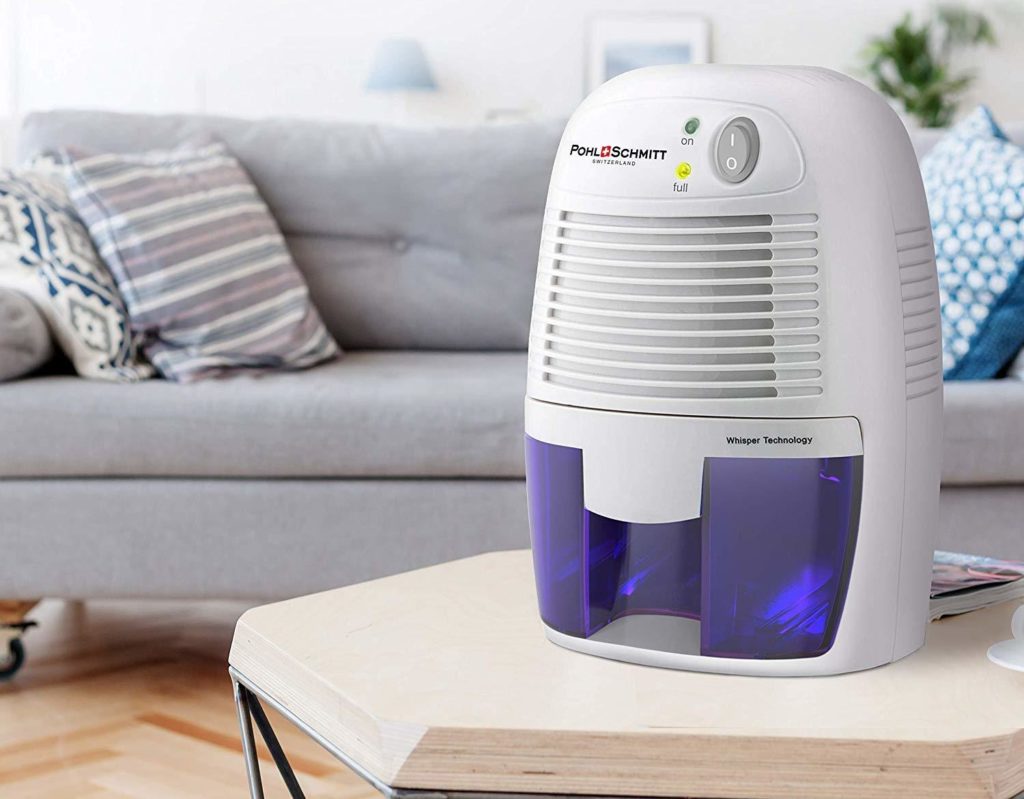Best Dehumidifier for Dust Mite Allergy | Buying Guide

Sometime in the 1950's, scientists first started using the term “micro-climate” to put forward the idea that there’s an entire array of local climate conditions that can differ greatly but be separated by just a few feet. That idea later got expanded to cover the human body and areas in the house, among other things.
In a micro-climate, which could be just a few inches across, there is a relatively stable “atmosphere” and the “weather” is unchanging.
For example, the armpits have their own micro-climate and so do does the area in the kitchen sink or under the bed.
More...
At a Glance: Our Top Picks of Dehumidifiers for Dust Mite Allergies
The problem arises when the micro-climate goes unchecked for so long that it starts favoring certain pests, which then colonize it and start spreading trouble.
For armpits, these would be bacteria that produce body odor; for the kitchen sink, it’s mold that creates the gunk and for the area under the bed it could very well be – dust mites.
Controlling the micro-climate
When dust mites colonize a micro-climate in your house, they rapidly spread everywhere they can, looking for warm, humid places with lots of fabric to lay their eggs in.
Unless you’re a hypochondriac, by the time you start feeling the symptoms, your house is probably already teeming with the buggers.
To head them off at the pass, you should look into getting a dehumidifier to curb their spread and then systematically eradicate them from one micro-climate at a time, focusing on clearing out their eggs from fabric.
Read on to understand how a dehumidifier works, dust mites spread, the allergic symptoms they create and how to choose the best dehumidifier for dust mite allergy.
Best Dehumidifiers for Dust Mite Allergy
- COP: 2.4 l/kWh
- Internal Corrosion Protection to minimize corrosion and Freon leakage
- Our choice for Dust Mite Allergies
- Coverage: Up to 3800 ft²
- Removes up to 9 gal/day of moisture
- Perfect for those who want low maintenance
- Coverage: Up to 7000 ft²
- Removes up to 17 gal/day of moisture
- Great for any sized room; enormous coverage with compact size
- Coverage: Up to 2300 ft²
- Highly energy efficient, drawing on 5.4 amps on a 115 volt power supply
- Designed for Commercial and Industrial application
- Removes up to 0.6 gal/day of moisture
- Auto shut-off when full
- Ideal choice for light sleepers or nappers like night-shift workers, elderly, babies, college students
- Removes up to 8.75 gal/day of moisture
- Low temperature operation saves energy and money
- Amazon's choice
Why does humidity matter?
In a regular household, there is a constant circulation of water as it evaporates, gets carried by the air movement, condenses, pools together and then evaporates again.
We most often don’t even realize that’s what’s going on unless we pay close attention to this cycle that also occurs in nature.
Just like in nature, there is a circulation of water in the house environment that can go awry and cause us trouble. Each micro-climate inside the house can also have its own evaporation and condensation cycle, depending mostly on temperature.
To evaporate, the temperature needs to be high enough; to condense, the temperature needs to be low enough and the perfect conditions for this are where the warm and cold air meet.
You’ve probably seen the sweating window panes during the winter, which go to show that:

What happens when humidity is too high/low?
The main problem with humidity is that we are delicate beings and require just the right humidity level to avoid discomfort and health problems.
For example, when the humidity goes too high, we get unwanted visitors, such as dust mites. On the flip side, when it drops too low, we experience sore throats, stuffed sinuses, and flaky skin.
To keep unwanted visitors at bay, we should constantly check the indoors micro-climate humidity and make sure they aren’t too humid. For example, we might open windows every once in a while to let the excess moisture out.
You could also wipe up excess moisture after every shower or after each time the kitchen sink faucet is opened. Putting a chunk of quicklime into a bucket and setting it in the corner of the room to absorb moisture works too, though the quicklime gets spent after a while, is troublesome to dispose of and burns the skin on contact.
If opening the windows, wiping up each drop or using quicklime doesn’t work or ends up being too much hassle, it’s time for a home appliance, namely a dehumidifier.
Let’s take a look at what makes the best dehumidifier for dust mite allergy.
What is a dehumidifier?
A device used to reduce humidity in a house micro-climate is called a dehumidifier, meaning it can be set at a specific spot, such as below the kitchen sink.
They are most commonly used to reduce humidity after a flood or when a water pipe bursts but can be used at any time to reduce the negative effects of increased humidity.
Dehumidifiers come in all shapes and sizes, ranging from bare bones to deluxe models with bells and whistles.
More elaborate models have a water hose that connects to the sewer network and automatically dumps collected water but simpler models have a bucket that has to be emptied manually.
Both simple and elaborate dehumidifiers work on the exact same principle, that being of condensation as we explained above.
The indoor air is sucked into the unit where it’s first heated and then let to run across a chilled surface, which generates condensation and lets the moisture drip into the bucket.
You should use a humidity sensor to find out the exact humidity in the micro-climate; the optimal range is 40-50% but you should go as low as you can in spots where you won’t spent much time.
Some dehumidifier models come with an in-built sensor, making it that much easier to figure out where the problem lies.
How do dust mites cause health problems?

In the case of dust mites, the problem lies, at least in part, in the relative humidity.
Dust mites mature in 3-4 weeks, with the female able to lay 40-80 eggs, colonizing an entire house within a year of infestation, embedding themselves in fabrics.
Whenever the humidity drops low, the dust mites lay low but it’s during spurts of high humidity that they spring into a feeding and breeding frenzy.
Dust mites feed on dead skin cells, textile fibers and each other. As they feed, live, lay eggs and die, they produce allergens that can cause an allergic reaction.
The allergens they produce get broken down and mixed with other house dust which, when disturbed, gets inhaled to enter the lungs and cause inflammation.
The smaller the particles, the more they can penetrate the lungs.
According to a 2015 EU study titled “Respiratory allergy caused by house dust mites: What do we really know?”, some 65-130 million people in the world suffer from some form of allergic reaction to dust mites.
In people with asthma, nearly 50% of them also experience trouble when exposed to dust mites, which turn out to be very prone to triggering allergic symptoms.
The study states “Humidity is a critical factor for mite prevalence both inside and outside the home, with higher concentrations found in damp homes”.
The highest concentration of dust mites is found in the pillow, mattress and bedding, since we sweat in sleep, soaking the fibers with humidity that helps mites thrive.
Other ways to exterminate dust mites include encasing the pillow in a mite-proof casing, daily vacuuming of mattresses and central heating but the primary control is keeping the humidity low using the best dehumidifier for dust mite allergy.
Can you kill dust mites by running a dehumidifier?

As the relative humidity increases, so does the dust mite population. At 75-85% relative humidity, the dust mite population gorges on any available food, but it’s at this stage that they are thwarted by another invader – mold.
As the relative humidity decreases, so does the dust mite activity and population.
Below 50% humidity and at 25 °C (77 °F), dust mites can survive for 5-11 days.
However, they have a protonymph stage that can bury itself within surfaces and go dormant, surviving for months at low humidity and against vacuuming, springing up when they feel ambient water vapor.
Dust mites are 70-75% water by weight and need ambient water vapor to survive; without this water, they can’t reproduce and die off.
Therefore, using a dehumidifier will inhibit the growth and reproduction of dust mites.
What is the ideal humidity to resolve dust mite allergy symptoms?
Allergic symptoms stemming from dust mite allergens will get exacerbated the more dust is floating in the air.
To resolve the allergic symptoms, the best option is to control relative humidity to 40-50%.
Humidity lower than 40% will tend to dry the air too much, making your skin flake and produce more dust.
On the other hand, a humidity higher than 50% will cause the mites to enter their feeding and breeding stage, exacerbating the symptoms.
Things to Consider when Buying a Dehumidifier for Your Dust Mite Allergy
Dehumidifier Capacity
Capacity refers to the maximum amount of moisture a dehumidifier will remove in 24 hours. For example, a 55 pint dehumidifier is rated to remove 55 pints of moisture from the air in a 24 hour period.
A dehumidifier for dust mite allergies should be powerful enough to quickly cycle through the available air as soon as possible.
When dust mites get exposed to moisture for mere 3 hours a day, they start to feed, breed and die, creating pockets of dust mite allergens that can get kicked up and enter your lungs.
Tank Size
While your dehumidifier may be removing 55 pints of moisture in a day, the unit may only have a 30 pint storage tank, meaning you will need to manually empty the reservoir bucket in order to achieve the unit's maximum capacity.
Hence, while you can run your unit non-stop, it is only limited by it's storage tank size.
Dust mites could be crawling all over your carpet, but as long as you have a strong dehumidifier to suck out the humidity, they won’t be triggering your allergic symptoms. For that, the unit should be able to run 24/7 or with minimal downtime.
You might also notice your dehumidifier blowing out hot air, which is normal, but too much heat being emitted may be a cause for concern.
Unit Size
The dehumidifier should also be compact enough to fit small spaces, as needed. If you detect a higher humidity in one micro-climate in your house, you should have the option of putting the unit right where it’s needed; for that, a remote control can be real handy.
Humidity Settings
You could find a use for every humidity setting on a dehumidifier in the right circumstances. Having a wide range of humidity settings (such as auto-shut off, humidity gauges, and fan settings) is a useful feature.
BEST DEHUMIDIFIER FOR DUST MITE ALLERGY
#1 AlorAir Sentinel HD55
A dehumidifier that has to stop and start to defrost will waste precious time that could be spent desiccating. For reliable performance, you need something special.
The AlorAir Sentinel HD55 has a hot gas valve defrosting system allowing for 24/7 operation in low temperatures down to 36°F (2 °C) without freezing.
Regardless of any local weather change and even as the temperature starts dropping to freezing point, this dehumidifier will keep chugging along.
The piping on the hot gas defrosting system is somewhat more complicated and expensive than the electrical equivalent but the upsides are less energy spent and a shorter defrost period.

The engineers that built this unit didn’t try to second-guess your intentions or try to limit how far you want to take your dehumidifying.
With the ability to control relative humidity between 35-90%, controls provide great flexibility and ensure you can place the unit anywhere and still have it perform just as you desire.
Simply cycle between high and low humidity, with Amazon reviews reporting the accuracy of plus or minus 3%.
In terms of it's capacity, up to 55 pints (26 l) of moisture is removed per day and drained through the supplied tubing.
Do keep in mind that this model doesn’t have the safety floater that would shut off the unit in case the tubing or the drain gets clogged.
There is no internal pump either, meaning you’ll have to ensure the tubing has a solid decline and doesn’t sag.
One excellent feature is this dehumidifier's compatibility with an attachable remote control. This allows the unit status to be shown on a mounted display using an RJ 45 connection. While an optional feature on the unit, it offers you effortless humidity checking and control.
Although fairly heavy at around 25 kg (57 lbs), the unit does have two handles to be lugged around by two people.
Noise may be an issue for lighter sleepers though. With levels around 60 dB, it is as loud as the conventional air conditioning unit, which could be a problem if you spend a lot of time in the same room.

AlorAir Sentinel HD55's filter
There were a handful of reports by users that the unit stopped working after a few months. However, most users report the AlorAir Sentinel HD55 to be an effective and reliable unit, still being in use after a few years!
In addition, with the manufacturer's massive 5-year warranty, simply get the unit replaced should you encounter any issues and you're good to go. Another key point for us was that you can install the dehumidifier yourself (i.e.: not installed professionally) and still have the warranty valid.
This dehumidifier is certainly effective and does the job to keep dust mite allergies under control.
Even if you don't suffer from dust mite issues, give this machine a try and you may find yourself sleeping more soundly and feeling more alert during the day.
Other Great Humidifiers for Dust Mite Allergy (Honorable Mentions)
#2 Aprilaire 1830 Pro
#3 Dri-Eaz Revolution LGR
#4 AlorAir Storm LGR Extreme
#5 Pohl+Schmitt Compact Dehumidifier
#6 Frigidaire FFAD7033R1 70-Pint Dehumidifier
Bottom Line - Best Dehumidifier for Dust Mite Allergy
Best Overall | Easy Maintenance Option | Best for Whole-House | Commercial & Industrial Grade | Best for Portability | Amazon's Choice | |
|---|---|---|---|---|---|---|
Cell | ||||||
Cell | AlorAir Sentinel HD55 | Aprilaire 1830 Pro | Dri-Eaz Revolution LGR | AlorAir Storm LGR Extreme | Pohl+Schmitt Compact Dehumidifier | Frigidaire 70-pint Dehumidifier |
Price | ||||||
Moisture Removal (Capacity) | 55 pints / day | 95 pints / day | 136 pints / day | 85 pints / day | 0.6 pints / day | 70 pints / day |
Coverage | 1300 ft² | 3800 ft² | 7000 ft² | 2300 ft² | Small rooms only | Small to Medium Sized Rooms |
Dimensions (inches) | 19.2 × 12.2 × 13.3 | 25 x 12.5 x 14.5 | 12.5 x 21.5 x 12.5 | 22.8 × 13.7 × 17.3 | 11.2 x 6.5 x 5.2 | 11.6 x 15 x 24.4 |
Draining Method | Gravity Draining | Hose / Over Drain | Auto Pump | Condensate Pump | Storage Tank | Storage Tank |
Storage Tank Size | - | - | - | - | 17 oz | 1 pint |
The media are constantly harping on about the need to preserve the climate and stop climate change but nobody’s talking about the micro-climate and how it changes. Arguably, the latter is much more relevant to our health and much more under our control.
We’re constantly struggling with all sorts of invaders for control over micro-climates in our immediate vicinity. Eventually, we have to start using technology or the struggle becomes too burdensome.
To help you in that struggle, relieve some of that burden and help you repel invading dust mites, you should consider using a dehumidifier.
They comes in all shapes and sizes but in this article we’ve chosen a hefty one – AlorAir's Sentinel HD55 - as the overall best dehumidifier for dust mite allergy.
The Sentinel HD55 shows a good balance of performance and price, letting you dehumidify as little or as much as you want at an affordable cost.
The remote control and the hot gas valve defrosting are two nice quality-of-life features that minimize micromanaging of the dehumidifier as it draws the excess moisture out of the air, and with it, dries out all the pesky dust mites.
The model recommended here is the base version; for all the added bells and whistles, check out the 90-pint model.














